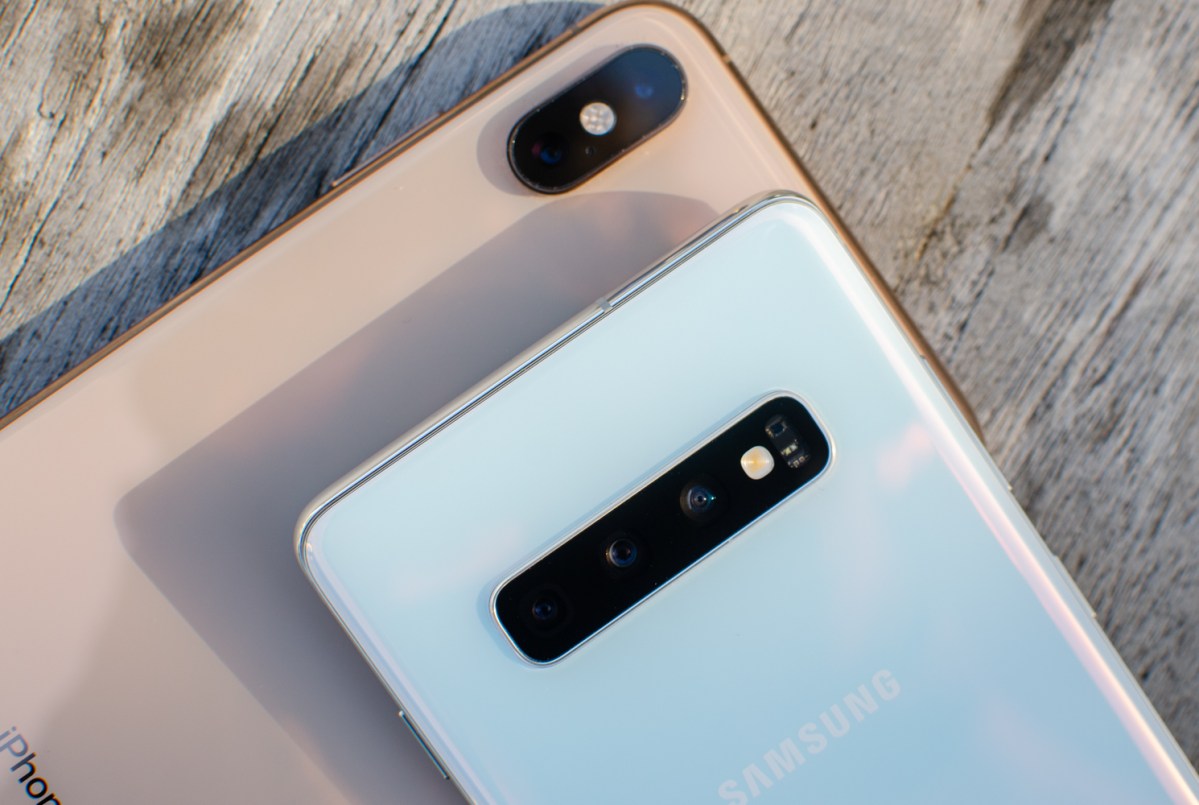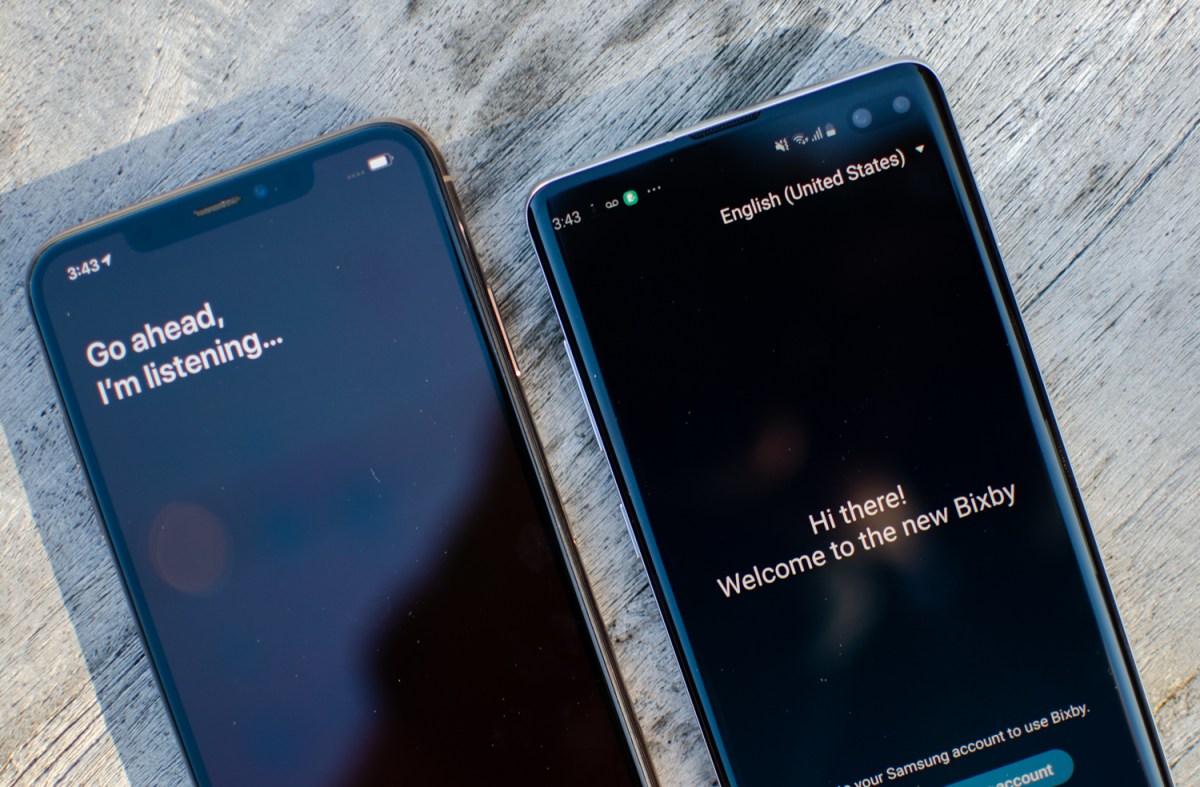Watch out plus-sized phones, there’s a new king in town. Samsung has taken the wraps off its new Galaxy S10 range, and it has spared no expense in upgrading its signature flagship range. If you’re a fan of phablets, the Galaxy S10 Plus has probably caught your eye — and with the Snapdragon 855, five camera lenses, and a 6.4-inch Dynamic AMOLED display, we can see why.
But a big phone attracts big competition, and the iPhone XS Max is one of the biggest. Samsung vs. Apple is one of the greatest rivalries around, but which wins when these two phones go head-to-head?
Specs
| Samsung Galaxy S10 Plus | Apple iPhone XS Max | |
| Size | 157.6 x 74.1 x 7.8 mm (6.20 x 2.91 x 0.30 inches) | 157.5 x 77.4 x 7.7 mm (6.20 x 3.05 x 0.30 inches) |
| Weight | 175 grams (6.17 ounces) | 208 grams (7.34 ounces) |
| Screen size | 6.4-inch Dynamic AMOLED | 6.5-inch Super Retina HD OLED True Tone display |
| Screen resolution | 3,040 × 1,440 pixels (526 pixels per inch) | 2,688 x 1,242 pixels (458 pixels per inch) |
| Operating system | Android 9.0 Pie | iOS 12 |
| Storage space | 64GB, 256GB, 512GB | |
| MicroSD card slot | Yes | No |
| Tap-to-pay services | Google Pay, Samsung Pay | Apple Pay |
| Processor | Qualcomm Snapdragon 855 | Apple A12 Bionic |
| RAM | 8GB, 12GB | 4GB |
| Camera | Triple lens 16-megapixel ultra wide-angle, 12MP variable aperture, and 12MP telephoto rear, 10MP and 8MP front dual lens | Dual 12MP (with dual OIS) rear, 7MP TrueDepth front camera |
| Video | 4K at 60 fps, 1080p at 240 fps, 720p at 960 fps | 4K at 60fps, 1080p at 240fps |
| Bluetooth version | Bluetooth 5.0 | Bluetooth 5.0 |
| Ports | USB-C port, 3.5mm audio jack | Lightning |
| Fingerprint sensor | Yes, ultrasonic in-display | No |
| Water resistance | IP68 | IP68 |
| Battery | 4,100mAh
Fast charging (QuickCharge 2.0) Qi wireless charging |
3,174mAh
Fast charge capable (Additional charger needed) Qi wireless charging |
| App marketplace | Google Play Store | Apple App Store |
| Network support | T-Mobile, AT&T, Verizon, Sprint | T-Mobile, AT&T, Verizon, Sprint |
| Colors | Prism Black, Prism White, Prism Blue, Flamingo Pink, Ceramic Black, Ceramic White | Silver, Space Gray, Gold |
| Price | $1,000 | $1,100 |
| Buy from | Samsung | Apple |
| Review score | 4.5 out of 5 stars | 4 out of 5 stars |
Performance, battery life, and charging

You want power? Both these devices put an incredible amount of power at your fingertips and will allow you to play the latest 3D games, view amazing augmented reality (AR) content, and more. You’ll find Apple’s A12 Bionic processor in the iPhone XS Max, while the Galaxy S10 Plus uses the all-new Snapdragon 855. We haven’t had a chance to test the S10 Plus properly yet, but some initial Snapdragon 855 benchmarks suggest it could eclipse the XS Max in pure power. However, it’s not likely to translate to better real-life performance, as the XS Max is silky-smooth.
The S10 Plus has the edge in RAM with 8GB, and the base model comes with 128GB of storage and room to expand via MicroSD card. The iPhone XS Max makes do with 4GB of RAM and 64GB of storage in the base model with no expansion option. The RAM difference may not be very telling, as the two platforms handle memory differently, but the extra storage will be important for some people.
Both of these phones also come with the biggest batteries in their range — 4,100mAh in the S10 Plus and 3,174mAh in the XS Max. Again, we haven’t had much chance to play with the S10 Plus, but at least a day’s worth of use between charges is expected. The XS Max delivers similar usage. Battery charging is where both fall slightly. Samsung persists in including the outdated QuickCharge 2.0, and it means fast charging isn’t as fast as what you can expect from the XS Max. However, you’ll need to buy an additional fast charger for the XS Max, as it doesn’t come with one in the box. Qi wireless charging is included in both.
Since we haven’t had much time with the S10 Plus yet, performance is tough to judge, so we’re going to call this a tie for now.
Winner: Tie
Design and durability

The Samsung Galaxy S10 Plus is one exceptionally beautiful phone, and Samsung’s new design includes a display with a hole-punch camera. Simply put, the front of the phone is almost all display, except for a single cutout for the dual front-facing cameras. It’s an exceptionally clean design, and that cleanness extends to the glass back too. There you’ll find three camera lenses and no fingerprint sensor — as it has moved into the display. The 512GB and 1TB models will also come with a ceramic back plate, rather than glass, which offers improved durability and an exceptionally luxurious feel.
But the XS Max is no stranger to luxurious beauty, and Apple’s supersized phone is definitely a match for Samsung’s on a style front. The new gold effect is quite stylish, and the edge-to-edge notched design has quickly become iconic, despite some people still disliking the notch.
You’ll find IP68 water-resistance on both, so they can survive a slip into the pool or bath. Glass is glass though, so you might want to slap on a case regardless of your choice. The ceramic-backed S10 Plus will be more durable, but ceramic is still prone to shattering, so it’s still even here.
There’s no obvious winner here — both are beautiful, fragile phones. It’s a tie.
Winner: Tie
Display

The iPhone XS Max packs a beautiful 6.5-inch AMOLED screen running a 2,688 x 1,242-pixel resolution. Apple’s penchant for odd resolutions aside, the screen is beautiful — it’s bright and crisp, and shows vibrant colors and deep, inky blacks. TrueTone, Dolby Vision, and HDR10 are back too, so expect some excellent viewing.
But Samsung makes the best phones screens in the business, and its latest are its best yet. The S10 Plus is packing a 6.4-inch Dynamic AMOLED display, and it’s a beauty. The first phone screen to be HDR10+-certified, it filters blue light, and offers incredible color accuracy. It’s also running a extremely crisp 3,040 x 1,440-pixel resolution.
While the iPhone XS Max’s display is beautiful, the S10 Plus’ screen hits a new level.
Winner: Samsung Galaxy S10 Plus
Camera

The iPhone XS Max has two rear-facing lenses — both 12-megapixels, with a f/1.8 and f/2.4 aperture respectively. The second lens is a telephoto lens, which helps with portrait mode shots. It’s a stunner of a camera, and easily one of the best camera phones. The 7-megapixel TrueDepth front camera also takes great selfie shots, and you can capture 4K video at 60 frames-per-second with the rear camera’s video capabilities.
The S10 Plus has really taken things up a notch, though. It’s packing a triple-lens camera — a 12-megapixel lens with variable aperture, another 12-megapixel telephoto lens, and a new 16-megapixel wide-angle lens. The front camera uses two lenses, a 10-megapixel and an 8-megapixel lens — which should hopefully improve selfie shots. Both front and rear cameras will also record 4K video. We haven’t had a chance to play with the S10 Plus’ camera system yet, but camera specialist DxoMark has awarded it the highest rating for selfies, and placed the rear cameras at the top of the heap along with the Huawei P20 Pro and Mate 20 Pro.
You’ll get a phone with a phenomenal camera regardless of which you choose, but we think the versatile S10 Plus camera suite is a winner.
Winner: Samsung Galaxy S10 Plus
Software and updates

The S10 Plus runs Samsung’s new One UI software based on Android 9.0 Pie. We really like it — it’s much better than previous Samsung UIs. But is it better than the iPhone XS Max’s iOS 12? A lot of that will be personal preference, so we can’t really judge for you.
Updates don’t come down to personal preference, though, and it’s here that Apple runs away with it. Since it creates and distributes the OS itself, Apple’s iOS updates have always been extremely prompt and come to a lot of older iPhones. The last iOS 12 update came to 2013’s iPhone 5S. By comparison, it takes Samsung months to update to the latest Android version, and most phones can usually only expect to see two major upgrades — three at most. By comparison, the aforementioned iPhone 5S started on iOS 7, and has been upgraded ever since.
Winner: iPhone XS Max
Special features

There phones are packed with the latest tech, from the AR-powered Memojis and AR Emojis, to the range of available A.I. assistants. While the S10 Plus has the advantage in sheer number of features — the Dex desktop mode, virtual reality support, and reverse wireless charging with Wireless PowerShare — we think the audience for these will be fairly niche.
Of much larger interest are the unlocking features available on both. The XS Max eschews a fingerprint scanner in favor of Face ID facial unlocking. It’s fast, and thanks to the TrueDepth camera, it’s secure too. The S10 Plus still uses a fingerprint scanner, but it’s been moved inside the display, and it uses ultrasonic technology — which Samsung claims boosts security. While it’s impressive, we’ll need some time with it before we can judge which is better.
Winner: Tie
Price
The iPhone XS Max is currently available, and prices start at $1,100 for the 64GB model. It’s available from a variety of retailers, and works on most major U.S. carriers. The Samsung Galaxy S10 Plus is currently available for pre-order, and releases March 8. The 128GB model costs $1,000, and it will also work on all major U.S. retailers.
Overall winner: Samsung Galaxy S10 Plus
As ever with these two brands, it’s an exceptionally tight race — but the Galaxy S10 Plus takes the title with just one more category than the iPhone XS Max. But there are a lot of ties, and we haven’t had much chance to play with the S10 Plus yet, so this verdict may change during our testing period. It’s also worth pointing out that many of the elements that matter most to people — performance and battery life span — came up tied. While the S10 Plus has a superior display and likely a superior camera, most users will be more than happy with both of those things on the iPhone.
So really, it all comes down to personal taste — do you love iOS or Android? Either way, we think you’ll be satisfied with whichever one of these amazing phones you choose.


